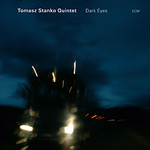
Dark Eyes
 $40.00
Out of Stock
$40.00
Out of Stock6+ weeks add to cart more by this artist
Tomasz Stanko Quintet
Dark Eyes
[ ECM Records / CD ]
Release Date: Monday 14 December 2009
This item is currently out of stock. It may take 6 or more weeks to obtain from when you place your order as this is a specialist product.
Tomasz Stanko's smouldering improvisations and grainy-toned trumpet find a new context on 'Dark Eyes'.
Like Miles Davis (a major influence) before him, the Polish jazz master also has an impressive record as talent scout and mentor, and his latest ensemble pools young players from the North of Europe. Tomasz has had strong connections to Finland in particular since the early 1970s when he was part of Edward Vesala's creative circle. Now he welcomes two prodigiously gifted Finns into his group, pianist Alexi Tuomarila and drummer Olavi Louhivuori, both expressive and imaginative players. On 'Dark Eyes', Jakob Bro, the young guitarist heard on ECM on Paul Motian's 'Garden of Eden' is cast most often in the role of subtle colourist, while fellow Dane Anders Christensen, on electric bass throughout, provides the band's throbbing pulse.
If the band is 'Nordic', Stanko's inspirations are more broadly cosmopolitan. These days, he splits his time between homes in Warsaw and New York, and two of the titles on 'Dark Eyes' - "Grand Central" and "Amsterdam Avenue" - are directly inspired by New York locales. A third, the album's title track, takes its cue from an encounter with an Oskar Kokoschka canvas at the Neue Galerie on Fifth Avenue. Stanko was struck by the expressionist intensity of Kokoschka's painting "Martha Hirsch (Dreaming Woman)" and the haunted, hollowed-eyed gaze of its subject, subsequently "translating", as he says, the emotional impact of the work, its "dimension of feeling", into sound. "Everything you experience gets into the music, but I've always been touched as much by art as by anything else in life. Fiction, poetry, film, the theatre. The visual arts especially. The way a painter uses paint, or the way he approaches form - distorting it to abstraction, or painting naturalistically or poetically... these aspects can be paralleled in my musical language, in the way I shape a melody line. "